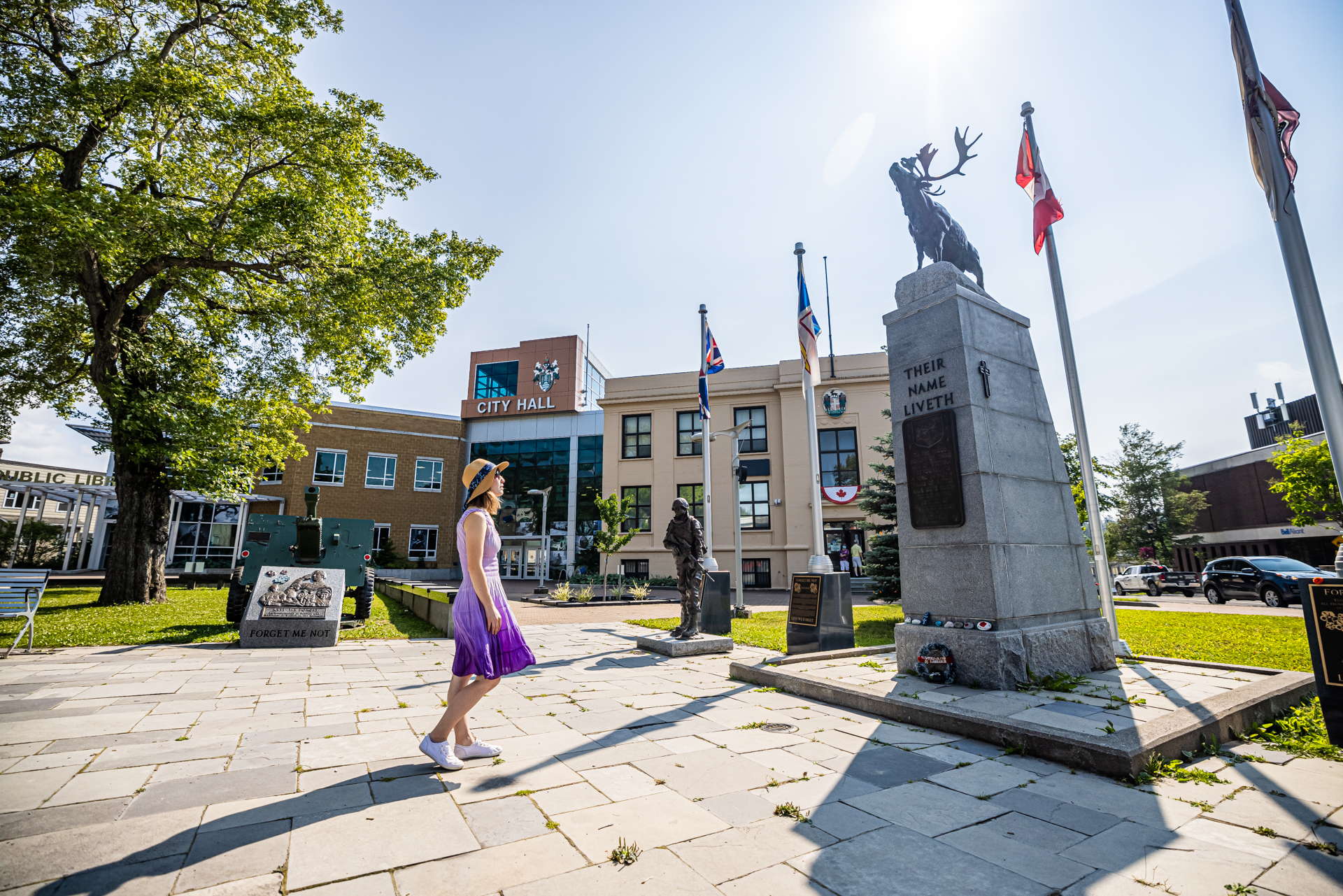Snowclearing FAQs
1. I live on a corner lot. Why do I get more snow from the plow than others on my street?
Residents living on corner lots or the first driveway to the right of an intersection typically get more snow deposited on their property and in their driveway. When the loader reaches each of these two areas they typically have more snow on their blade than on a straight section of road with periodic driveways. While snow clearing on a residential street, the plow takes the snow from the center of the road and deposits it on the side of the road, filling driveways as it passes. When a plow turns right at the end of a street, it is carrying snow on its blade and typically it is traveling from a side road to a main road that has already been snow cleared. When a plow reaches the end of a street it has to deposit the snow being carried on the blade. The plow usually keeps right and deposits the snow on the corner lot. Residents living on a corner lot will typically have snow deposited in their driveway when both roads adjacent to their property are plowed.
2. Why does the plow keep coming by when there has been no new snow?
It normally takes the City several days to completely clean up the streets and roads following a heavy snowfall event. Plowing snow to the sides of the roads is accomplished in several stages. The focus of the first stage is to keep the main section of the road clear of snow such that vehicles can safely travel the roads. The next phase involves pushing the snow back to widen the right of way as much as possible. Depending on the duration of the snowfall, plowing may continue with the goal of pushing snow back as far as possible to make room for more snow from upcoming snowfalls.
3. When is the City parking ban in effect?
The City parking ban will come into effect on December 1st and end on May 1st. The City of Corner Brook Traffic Regulations (Item #9, Overnight Parking) states “No person shall park any vehicle on any highways within the City between the hours of 12 a.m. and 8 a.m. provided that these Regulations shall not apply to ambulances or fire engines nor to motor vehicles operated by medical practitioners, clergy, police officers or City agents or employees, when being used in cases of emergency”.
4. How does the City decide the order of streets to plow?
The City plows primary streets first, secondary streets next and side streets last. There are 7 routes around the City for snow clearing purposes: Townsite, O’Connell Drive, Country Road and surrounding area, Humbermouth, Sunnyslope and surrounding area, Elizabeth Street and surrounding area, and Curling. During a snow event snow clearing equipment is sent to each route. Not all routes are the same size or the same difficulty level so some are finished in less time than others. When a piece of equipment finishes one route they either assist on the larger routes that are not finished or depending on the snow accumulation may have to start their same route again from the beginning. It is possible that primary and secondary streets have to be cleared a second time before side streets are cleared.
5. It’s been snowing for several hours, where are the City plows?
As mentioned in FAQ #4, the City’s streets and roads are divided into 7 zones, with each zone covered by 1 or 2 plows depending on their size and complexity. Under normal conditions it takes approximately 12 hours to completely plow each route. During heavy snow events the primary streets may have to be plowed more frequently, thereby extending the time to complete the route. Thus it’s possible that a given street may not see a plow for 12 hours or more after the plows have been mobilized.
6. How does the City decide to salt, sand or plow the roads?
During periods of light snowfall when the temperature is at approximately -8 degrees Celsius or about the City will apply salt to the roads. They will continue to apply salt as long as it appears to be working. When the snow starts to accumulate faster than the salt can work, a decision is made to start plowing. Once a road is plowed the City will sand the road (with a salt/sand mixture) to help melt the snow/ice remaining on the roads and provide traction for the hard packed material. When temperatures are colder than -8 C only sand is applied to the roads.
7. Why does my street get plowed in when the main road is plowed?
The City plows all main streets first which results in a “wing roll” being deposited at the entrance of each side street. It is a significant safety hazard for the plows to back up and remove this wing roll after it is deposited. Also, as the priority is always to keep primary streets clear, removing the wing rolls immediately would significantly extend the amount of time required to complete the primary streets.
8. Can City snow equipment operate during the night?
Yes. The City of Corner Brook Noise Regulations states “nothing in these Regulations shall prohibit the following; the removal or clearing of snow by equipment.”
9. If I have nowhere to throw my snow can I throw it into the street?
No. Residents of the City of Corner Brook are reminded that pushing snow into any street/roadway, as well as around fire hydrants, is in violation of City By-Laws and Regulations. Both practices place motorist and residents at risk. Residents are also asked, where possible, not to park on City streets during daytime snow clearing operations as this results in snow being left in the right-of-way.
10. Can I put a snow marker on my property?
Plastic or Wooden snow markers are permitted. Steel markers are not permitted due to the serious safety hazard they create. If steel markers are installed they will be removed and placed on the homeowner’s property. The City does not accept responsibility for plastic or wooden markers that are knocked down during snow clearing.
The City is not able to accommodate these request. It it not reasonable or practical to request the City snow clearing equipment to be selective in the driveways it pushes snow in front of. During a snow event the City has a large area to clear and the public expects it to be done in a timely manner. Accommodating these requests could cause safety issues and would considerably add to the time and cost associated with the snow clearing of City streets.
12. Is the City responsible for damage or debris as a result of snow plowing?
As stated in the Snow and Ice Control Policy (# 06-02-01) the City shall not be responsible for damage or clean up of lawns, flower beds, trees, etc caused by the accumulation of salt, sand or other debris remaining after snow banks melt or otherwise arising from snow clearing and ice removal.
13. What do I do if my home or vehicle is damaged by snow clearing equipment?
If you feel damage is done to your vehicle, home or property you must submit a letter of claim to the City Clerk, 2rd floor at City Hall stating the time and date of the incident and a description of the alleged damage, complete with pictures if possible. The claim will be reviewed and you will be notified of the decision by mail. More information on the City’s responsibilities is available in the City’s damage claims policy (policy # 06-02-01) which is available on the City of Corner Brook Website (www.cornerbrook.com).
14. What is Brine and why is the City considering to use it?
Brine is a liquid calcium chloride (salt) solution. Brine is applied directly to pavement and helps prevent the bond of snow to the pavement. Some benefits of using this solution include: 1) wet materials readily adhere to the roadway better than dry materials, 2) wet materials begin dissolving snowpack and ice faster than dry materials, 3) the quantity of materials can be reduced when pre-wetted, since less materials leave the roadway during spreading, operators report quicker melting with the pre-wetting process, which means better service to the traveling public.
15. When does the City decide to use the snow blowers?
Snow blowers are attachments that are installed on the loaders used to plow the snow. When weather allows, the plow blades are removed to allow installation of the blower attachments such that the City focuses on widening the streets and intersections. The snow blowers start on the main roads and school zones first and then move to the side streets. The City of Corner Brook currently has 2 snow blower attachments?
17. What streets does the sidewalk blower clear?
The sidewalk blower clears all sidewalks in the immediate vicinity of schools first. Next, sidewalks in business districts are cleared as well as primary streets, followed by secondary and side streets as required.
18. I live on a cul-de-sac and want the pile of snow in the center removed.
The City of Corner Brook, during the winter months, carries out snow clearing and snow removal from City owned streets and right-of-ways. A unique situation exists in cul-de-sacs wherein the right-of-way is narrower than most streets and little space is available for snow storage. Snow removal equipment will enter cul-de-sacs from the left lane and plow or wing snow away from the properties and deposit it in the center of the cul-de-sac. The procedure will be followed until approximately one half of the cul-de-sac is full or prior to the pile of snow interfering with an orderly flow of traffic around the cul-de-sac. Snow will then be removed from the cul-de-sac by way of trucks or loader and disposed of in an approved snow dumping site.
19. Who is responsible to keep a clear pathway to the fire hydrant in front of my house?
The City of Corner Brook removes snow from all City owned hydrants in an effort to protect public safety. Residents are not permitted to deposit snow near fire hydrants. Residents are encouraged to remove snow from around a hydrant if it is near their house.
No. Residents are permitted to clear snow from their driveway any time during the day or night as defined in the City of Corner Brook Noise Regulations. However, the City does ask residents to be respectful of their neighbors.
No. The City maintains a stockpile of sand at the northwest corner of the Civic Centre’s lower parking lot which may be picked up by the City of Corner Brook residents for private or institutional use.
The City of Corner Brook will not clear snow out of private driveways or at the end of a private driveway on the City easement. Depending on the amount of snow that falls any given time the amount of snow a person will have at the end of their driveway will vary. if a resident feels that there are pieces of ice left in their driveway by the snowplow that are too heavy for them to move they can report it to the Customer Service Line (1-709-637-1666) and a City foreman will assess the situation and determine if the complaint is valid. If, in rare cases, the foreman determines that the large pieces of ice are excessive he will make arrangements to have it removed when equipment is available.
23. Can potholes be fixed during the winter months?
Paving and compaction must be performed while the asphalt is sufficiently hot. In out climate paving with hot asphalt is restricted to the warmer months because in winter the air temperature and compacted base will cool the asphalt too much before it is sufficiently compacted. During these cold winter months pot holes are repaired using a product known as cold patch or cold asphalt. Cold patch is soft sticky out of the bag, but it quickly hardens after application and the end result is a pavement patch with better strength but similar properties to hot asphalt. It can be applied right from the package without heating. Cold asphalt also does not require any special heavy rolling machines or special applicators as it can be shovelled or poured into a pothole and tamped down with a hand tool.


